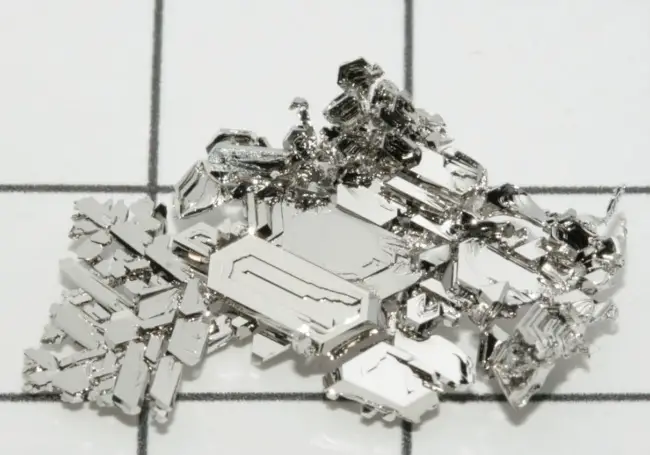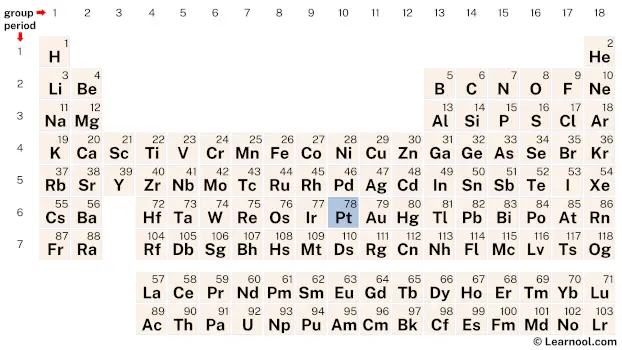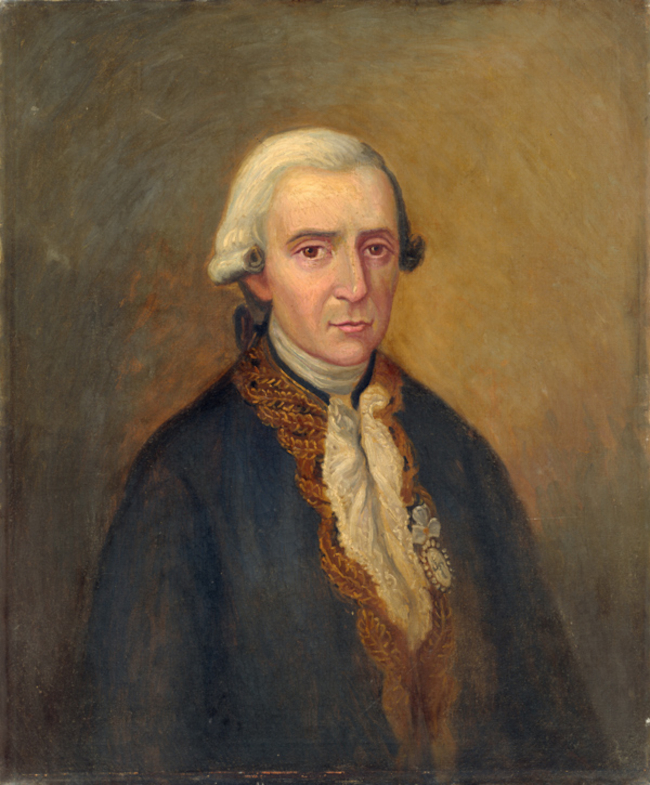
Platinum (Pt) is a chemical element of the periodic table, located in the group 10 and the period 6, and is having the atomic number 78. It is a soft, malleable, silvery-white transition metal, whose name comes from the Spanish word “platina”, which means little silver.
On periodic table
| group | ⇨ | 1 | 2 | 3 | 4 | 5 | 6 | 7 | 8 | 9 | 10 | 11 | 12 | 13 | 14 | 15 | 16 | 17 | 18 |
| period | ⇩ | ||||||||||||||||||
| 1 | 1 H  Hydrogen |
2 He  Helium |
|||||||||||||||||
| 2 | 3 Li  Lithium |
4 Be  Beryllium |
5 B  Boron |
6 C  Carbon |
7 N  Nitrogen |
8 O  Oxygen |
9 F  Fluorine |
10 Ne  Neon |
|||||||||||
| 3 | 11 Na  Sodium |
12 Mg  Magnesium |
13 Al  Aluminium |
14 Si Silicon |
15 P  Phosphorus |
16 S  Sulfur |
17 Cl  Chlorine |
18 Ar  Argon |
|||||||||||
| 4 | 19 K  Potassium |
20 Ca  Calcium |
21 Sc  Scandium |
22 Ti  Titanium |
23 V  Vanadium |
24 Cr  Chromium |
25 Mn  Manganese |
26 Fe  Iron |
27 Co  Cobalt |
28 Ni  Nickel |
29 Cu  Copper |
30 Zn  Zinc |
31 Ga  Gallium |
32 Ge  Germanium |
33 As  Arsenic |
34 Se  Selenium |
35 Br  Bromine |
36 Kr  Krypton |
|
| 5 | 37 Rb  Rubidium |
38 Sr  Strontium |
39 Y  Yttrium |
40 Zr  Zirconium |
41 Nb  Niobium |
42 Mo  Molybdenum |
43 Tc  Technetium |
44 Ru  Ruthenium |
45 Rh  Rhodium |
46 Pd  Palladium |
47 Ag  Silver |
48 Cd  Cadmium |
49 In  Indium |
50 Sn  Tin |
51 Sb  Antimony |
52 Te  Tellurium |
53 I  Iodine |
54 Xe  Xenon |
|
| 6 | 55 Cs  Caesium |
56 Ba  Barium |
72 Hf  Hafnium |
73 Ta  Tantalum |
74 W  Tungsten |
75 Re  Rhenium |
76 Os  Osmium |
77 Ir  Iridium |
78 Pt Platinum |
79 Au  Gold |
80 Hg  Mercury |
81 Tl  Thallium |
82 Pb  Lead |
83 Bi  Bismuth |
84 Po  Polonium |
85 At  Astatine |
86 Rn  Radon |
||
| 7 | 87 Fr  Francium |
88 Ra  Radium |
104 Rf  Rutherfordium |
105 Db  Dubnium |
106 Sg  Seaborgium |
107 Bh  Bohrium |
108 Hs  Hassium |
109 Mt  Meitnerium |
110 Ds  Darmstadtium |
111 Rg  Roentgenium |
112 Cn  Copernicium |
113 Nh  Nihonium |
114 Fl  Flerovium |
115 Mc  Moscovium |
116 Lv  Livermorium |
117 Ts  Tennessine |
118 Og  Oganesson |
||
| 57 La  Lanthanum |
58 Ce  Cerium |
59 Pr  Praseodymium |
60 Nd  Neodymium |
61 Pm  Promethium |
62 Sm  Samarium |
63 Eu  Europium |
64 Gd  Gadolinium |
65 Tb  Terbium |
66 Dy  Dysprosium |
67 Ho  Holmium |
68 Er  Erbium |
69 Tm  Thulium |
70 Yb  Ytterbium |
71 Lu  Lutetium |
|||||
| 89 Ac  Actinium |
90 Th  Thorium |
91 Pa  Protactinium |
92 U  Uranium |
93 Np  Neptunium |
94 Pu  Plutonium |
95 Am  Americium |
96 Cm  Curium |
97 Bk  Berkelium |
98 Cf  Californium |
99 Es  Einsteinium |
100 Fm  Fermium |
101 Md  Mendelevium |
102 No  Nobelium |
103 Lr  Lawrencium |
|||||
| – d block |
Platinum is a d-block element, found in the tenth column and the sixth row of the periodic table. It has the atomic number 78 and is denoted by the symbol Pt.
Element information
 |
|
 |
|
| Origin of name | Spanish word “platina” (which means little silver) |
| Symbol | Pt |
| Atomic number (Z) | 78 |
| Atomic mass | 195.084 u |
| Block | d-block |
| Group | 10 |
| Period | 6 |
| Classification | Transition metal |
| Atomic radius | 139 pm |
| Covalent radius | 136±5 pm |
| Van der Waals radius | 175 pm |
| Melting point | 1768.3 ℃, 3214.9 ℉, 2041.4 K |
| Boiling point | 3825 ℃, 6917 ℉, 4098 K |
| Electron configuration | [Xe] 4f14 5d9 6s1 |
| Electrons per shell | 2, 8, 18, 32, 17, 1 |
| Learn how to draw: Platinum Bohr model | |
| Crystal structure | Face-centered cubic (fcc) |
| Phase at r.t | Solid |
| Density near r.t | 21.45 g/cm3 |
| Main isotopes | Platinum-192, Platinum-194, Platinum-195, Platinum-196, Platinum-198 |
| Natural occurrence | Primordial |
| Oxidation state | +2, +4 |
| Electronegativity (Pauling scale) | 2.28 |
| Protons Neutrons Electrons |
78 117 78 |
| Learn how to find: Platinum protons neutrons electrons | |
| CAS number | 7440-06-4 |
| Discovered by | Antonio de Ulloa in 1735 |
History

Platinum has a long history of use by various civilizations around the world, with early evidence of its use dating back to ancient Egypt. Traces of platinum have been found in gold used in ancient Egyptian burials as early as 1200 BCE, although it is unclear if the Egyptians recognized that there was platinum in their gold. Native Americans in what is now modern-day Ecuador were also known to use platinum to create artifacts made from a white gold-platinum alloy, although it is difficult to determine precise dates and locations of these artifacts due to the way they were obtained through antiquities trade.
The first European reference to platinum was made in 1557 by Italian humanist Julius Caesar Scaliger, who described it as an unknown noble metal found between Darién and Mexico that could not be liquefied by fire or any Spanish artifice. Spanish explorers who encountered platinum generally viewed it as an impurity in gold, and it was often thrown away. It was not until 1735 when Antonio de Ulloa and Jorge Juan y Santacilia saw Native Americans mining platinum while they were traveling through Colombia and Peru for eight years that platinum was formally studied. Ulloa returned to Spain and established the first mineralogy lab, where he was the first to systematically study platinum. His description of platinum as being neither separable nor calcinable was published in 1748, after which other chemists across Europe began studying the metal.
One of the most significant early accounts of platinum was made by British metallurgist Charles Wood in 1741 when he found various samples of Colombian platinum in Jamaica and sent them to William Brownrigg for further investigation. After studying the samples, Brownrigg presented a detailed account of the metal to the Royal Society in 1750, noting that he had seen no mention of it in any previous accounts of known minerals. Brownrigg also noted platinum’s extremely high melting point and resistance to borax. Other chemists, including Andreas Sigismund Marggraf, Torbern Bergman, Jöns Jakob Berzelius, William Lewis, and Pierre Macquer, soon began studying platinum as well. Henrik Scheffer published a detailed scientific description of the metal in 1752, referring to it as “white gold” and noting that it was less pliable than gold but similarly resistant to corrosion.
Occurrence and production
Platinum is a relatively rare element, with an average abundance of just 5 parts per billion in the Earth’s crust. The majority of platinum reserves are located in the Bushveld Complex in South Africa, where approximately 70% of the world’s platinum is produced. Other significant deposits are found in Russia, North America, and Zimbabwe.
Platinum is typically extracted from its ores through a complex process that involves crushing, milling, and chemical treatment. The most common method of platinum production is through the refining of nickel and copper ores. The process involves the use of high temperatures and pressure to separate the platinum from other metals and impurities, resulting in a crude form of the metal known as “blister” or “sponge” platinum.
Once the crude platinum has been obtained, it undergoes further refining and purification to remove any remaining impurities. The purified platinum is then formed into ingots, which can be used for a variety of purposes, including jewelry, industrial applications, and investment.
Properties
Platinum is a silvery-white metal that is dense, malleable, and ductile.
Platinum has a very high melting point of 1768.3 ℃ and a boiling point of 3825 ℃, making it ideal for high-temperature applications.
Platinum is a dense metal with a density of 21.45 g/cm3, which is higher than most other common metals.
Platinum is highly resistant to corrosion, making it ideal for use in harsh chemical environments.
Platinum is a good conductor of electricity, making it useful for electrical contacts and other electronic applications.
Platinum is an effective catalyst for many chemical reactions, including the oxidation of hydrocarbons in automotive catalytic converters.
While rare, some people can develop an allergic reaction to platinum, making it important to handle the metal with care.
Applications
Jewelry
Platinum is a popular choice for high-end jewelry due to its durability, resistance to tarnish, and lustrous appearance.
Automotive
Platinum is a key component in automotive catalytic converters, which help reduce harmful emissions from vehicles.
Chemical manufacturing
Platinum is used as a catalyst in many chemical reactions, including the production of fertilizers, plastics, and pharmaceuticals.
Electronics
Platinum is used in various electronic components, including hard disk drives, LCD screens, and electrical contacts.
Medical
Platinum is used in medical applications, such as pacemakers, dental fillings, and chemotherapy drugs.
Investment
Platinum is also used as an investment, with many individuals and organizations holding platinum bullion or coins as a form of financial insurance.
Interesting facts
The name “platinum” comes from the Spanish word “platina,” which means “little silver.”
Platinum is denser than gold, with a density of 21.45 g/cm3 compared to gold’s 19.3 g/cm3.
Platinum is the most ductile metal, meaning it can be drawn into the thinnest wires without breaking.
The world’s largest platinum nugget was discovered in Russia in 1844 and weighed over 20 pounds.
Platinum is often used in the creation of laboratory equipment due to its resistance to corrosion and high melting point.
The purity of platinum is measured in parts per thousand, with “platine” referring to 950 parts per thousand pure platinum.
Platinum has been used to make coins, with the Russian government issuing platinum coins as legal tender in the early 20th century.
Platinum has been used to create prestigious awards, such as the Grammy Awards, which feature a gramophone statuette made of platinum.
Related
More elements
External links
- https://www.rsc.org/periodic-table/element/78/platinum
- https://en.wikipedia.org/wiki/Platinum
- https://www.britannica.com/science/platinum
- https://pubchem.ncbi.nlm.nih.gov/element/Platinum
- https://education.jlab.org/itselemental/ele078.html
- https://www.chemicool.com/elements/platinum.html
- https://www.livescience.com/39144-platinum.html
Deep
Learnool.com was founded by Deep Rana, who is a mechanical engineer by profession and a blogger by passion. He has a good conceptual knowledge on different educational topics and he provides the same on this website. He loves to learn something new everyday and believes that the best utilization of free time is developing a new skill.
